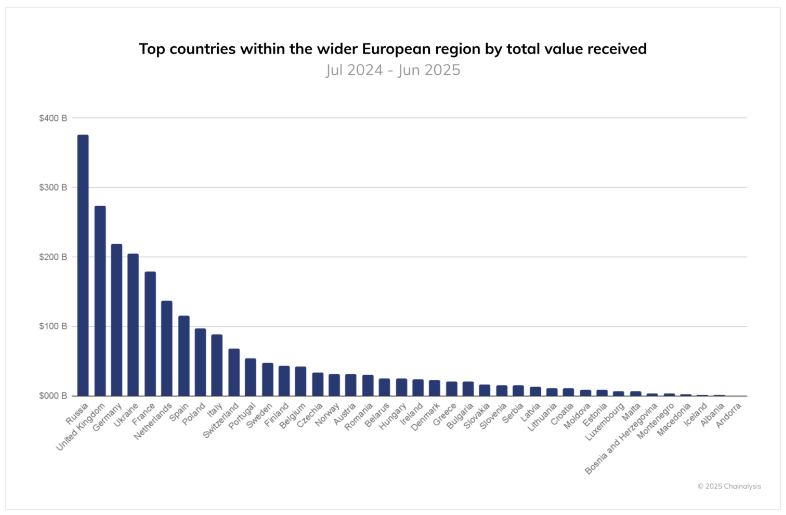Per the ever-reliable Chainalysis, Russia has been busily moving around $376 billion in crypto transfers between July 2024 and June 2025. 🧾💸 A feat that has left Europe scratching its head, trailing behind with a measly $273 billion. 🤷♂️
This metric, which tracks value funneled into Russian wallets and addresses, is said to be fueled by a mix of “very large transfers,” rising DeFi activity, and the rouble-linked stablecoin A7A5. Because nothing says “economic resilience” like a token that’s basically a digital ruble with a side of glitter. ✨
Big Transfers And DeFi Activity
Large transactions appear to have pushed the overall totals up. Transfers greater than $10 million rose by 86% in Russia over the year, a much faster increase than seen across other European markets. 🐟💰
DeFi activity also expanded sharply – rising roughly eightfold in early 2025 compared with mid-2023 levels before settling at about 3.5 times that earlier baseline. Those moves suggest that bigger players, including funds and institutional traders, are moving significant amounts on-chain. Because who needs a bank when you’ve got a blockchain? 🏦➡️📊

Stablecoins Drive Cross-Border Movement
Reports have pointed to a rouble-pegged stablecoin, known as A7A5, as one of the rails used for cross-border settlement. Enter A7A5, the rouble’s digital twin, zipping across borders like a crypto courier. 🚀
That token reached roughly $500 million in market capitalization in early October, and on-chain transfers tied to it topped $40 billion in recent months, according to blockchain trackers. Because nothing says “financial stability” like a token backed by a currency that’s still trying to find its footing. 📉
US and European officials have raised concerns about connections between some stablecoin flows and sanctioned entities, which has drawn extra attention to where the money is coming from and where it’s going. Because nothing sparks international drama like a token that’s both a lifeline and a red flag. ⚠️

Russia is also preparing formal digital money options. Based on reports, the central bank plans a national digital ruble launch on September 1, 2026, and lawmakers have discussed rules that could require major companies to support the CBDC from the start. Because nothing says “innovation” like a government-backed digital currency that’s still figuring out its purpose. 🤔
There has been talk of a national crypto bank and measures to open retail access to trading, steps that might shift some informal activity into regulated channels. Because nothing says “trust” like a state-run crypto bank. 🏛️💸
Pressure Points And Practical Effects
High transaction volume does not mean mass retail adoption across the population. Much of the growth is concentrated in wholesale flows – trading desks, settlement transfers, and firms using stablecoin rails. But let’s not get too excited – most of this crypto action is happening in the shadows of big banks and traders, not your local corner store. 🛒💸
That concentration makes the aggregate numbers large and real, but it also means the typical consumer may not be using crypto for routine payments. Still, the A7A5 case shows how quickly on-chain rails can scale when other payment routes are constrained. Because when in doubt, just build a blockchain. 🧱
Read More
- USD VES PREDICTION
- USD PLN PREDICTION
- FIL PREDICTION. FIL cryptocurrency
- EUR CNY PREDICTION
- JUP PREDICTION. JUP cryptocurrency
- BTC PREDICTION. BTC cryptocurrency
- INJ PREDICTION. INJ cryptocurrency
- STETH PREDICTION. STETH cryptocurrency
- NEAR PREDICTION. NEAR cryptocurrency
- JPY KRW PREDICTION
2025-10-18 19:14